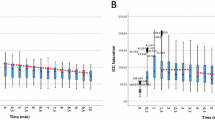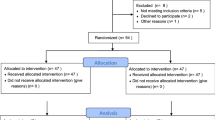Abstract
Background
India ink has been commonly used for preoperative colonic tattooing, but various complications have been reported. This study aimed to evaluate the usefulness of indocyanine green (ICG) marking as a replacement for India ink.
Methods
This study enrolled 40 patients who between January 2005 and February 2006 underwent laparoscopic or open surgery for colorectal lesions considered difficult to locate intraoperatively. Because one patient had a history of allergy to iodinated contrast material, metal clipping was used instead of ICG to mark the lesion. Endoscopists injected 5 ml of ICG suspension and saline solution adjacent to the lesion at duplicate locations to evaluate the visibility, duration, and adverse effects of the dye. For 39 patients, the date of the preoperative colonoscopy was not set for examination of the appropriate interval between endoscopic marking and the surgical operation.
Results
The median interval between ICG marking and surgery was 4 days (range, 1–73 days). All 29 patients who underwent surgery within 8 days after marking had positive green ICG staining at the time of surgery. After 9 days or more, however, positive staining was seen clearly in only two of the remaining 10 patients. The staining tended to grow weaker and fainter over the time course, eventually dissipating. No perioperative adverse reactions to the dye were observed.
Conclusion
This study supports the use of ICG as a safe technique that can be identified reliably during operations performed within 8 days after endoscopic injection.


Similar content being viewed by others
References
Ponsky JL, King JF (1975) Endoscopic marking of colonic lesions. Gastrointest Endosc 22:42–43
McArthur CS, Roayaie S, Waye JD (1999) Safety of preoperative endoscopic tattoo with India ink for identification of colonic lesions. Surg Endosc 13:297–400
Coman E, Brandt LJ, Brenner S, Frank M, Sablay B, Bennett B (1991) Fat necrosis and inflammatory pseudotumor due to endoscopic tattooing of the colon with India ink. Gastrointest Endosc 37:65–68
Park SI, Genta RS, Romeo DP, Weesner RE (1991) Colonic abscess and focal peritonitis secondary to India ink tattooing of the colon. Gastrointest Endosc 37:68–71
Lane KL, Vallera R, Washington K, Gottfried MR (1996) Endoscopic tattoo agents in the colon: tissue responses and clinical implications. Am J Surg Pathol 20:1266–1270
Dell’Abate P, Iosca A, Galimberti A, Piccolo P, Soliani P, Foggi E (1999) Endoscopic preoperative colonic tattooing: a clinical and surgical complication. Endoscopy 31:271–273
Hellmig S, Stüber E, Kiehne K, Folsch U (2003) Unusual course of colonic tattooing with India ink. Surg Endosc 17:521
Bahadursingh AM, Driver M, Koenig CL, Longo WE (2003) Inadvertent transmural India ink tattooing simulating intestinal infarction. Am J Surg 185:88–89
Yano H, Okada K, Monden T (2003) Adhesion ileus caused by tattoo marking: unusual complication after laparoscopic surgery for early colorectal cancer. Dis Colon Rectum 46:987
Hellmig S, Stüber E, Kiehne K, Kosmahl M, Folsch U (2005) What do we really know about the long-term safety of colonic tattooing? Gastrointest Endosc 61:186–187
Fu KI, Fujii T, Kato S, Sano Y, Koba I, Mera K, Saito H, Yoshino T, Sugito M, Yoshida S (2001) A new endoscopic tattooing technique for identifying the location of colonic lesions during laparoscopic surgery: a comparison with the conventional technique. Endoscopy 33:687–691
Sawaki A, Nakamura T, Suzuki T, Hara K, Kato T, Kato T, Hirai T, Kanemitsu Y, Okubo K, Tanaka K, Moriyama I, Kawai H, Katsurahara M, Matsumoto K, Yamao K (2003) A two-step method for marking polypectomy sites in the colon and rectum. Gastrointest Endosc 57:735–737
Askin MP, Waye JD, Fiedler L, Harpaz N (2002) Tattoo of colonic neoplasms in 113 patients with a new sterile carbon compound. Gastrointest Endosc 56:339–342
Hammond DC, Lane FR, Welk RA, Madura MJ, Borreson DK, Passinault WJ (1989). Endoscopic tattooing of the colon: an experimental study. Am Surg 55:457–461
Price N, Gottfried MR, Clary E, Lawson DC, Baillie J, Mergener K, Westcott C, Eubanks S, Pappas TN (2000) Safety and efficacy of India ink and indocyanine green as colonic tattooing agents. Gastrointest Endosc 51:438–442
Lee JG, Low AH, Leung JW (2000) Randomized comparative study of indocyanine green and India ink for colonic tattooing: an animal survival study. J Clin Gastroenterol 31:233–236
Hammond DC, Lane FR, Mackeigan JM, Passinault WJ (1993) Endoscopic tattooing of the colon: clinical experience. Am Surg 59:205–210
Hope-Ross M, Yannuzzi LA, Gragoudas ES, Guyer DR, Slakter JS, Sorenson JA, Krupsky S, Orlock DA, Puliafito CA (1994) Adverse reaction due to indocyanine green. Ophthalomol 101:529–533
Caeser J, Shaldon S, Chiandussi L, Guevara L, Sherlock S (1961) The use of indocyanine green in the measurement of hepatic flow and as a test of hepatic function. Clin Sci 21:43–57
Hiratsuka M, Miyashiro I, Ishikawa O, Furukawa H, Motomura K, Ohigashi H, Kameyama M, Sasaki Y, Kabuto T, Ishiguro S, Imaoka S, Koyama H (2001) Application of sentinel node biopsy to gastric cancer surgery. Surgery 129:335–340
Ram E, Sherman Y, Weil R, Vishne T, Kravarusic D, Dreznik Z (2005) Is mechanical bowel preparation mandatory for elective colon surgery? Arch Surgery 140:285–288
Ashida R, Yamao K, Okubo K, Sawaki A, Mizuno N, Nakamura T, Tajika M, Kawai H, Shimizu Y (2006) Indocyanine green is an ideal dye for endoscopic ultrasound-guided fine-needle tattooing of pancreatic tumors. Endoscopy 38:190–192
Hyman N, Waye JD (1991) Endoscopic four-quadrant tattoo for the identification of colonic lesions at surgery. Gastrointest Endosc 27:56–58
Ferencz M, Somfai GM, Farkas A, Kovacs I, Lesch B, Recsan Z, Nemes J, Salacz G (2006) Functional assessment of the possible toxicity of indocyanine green dye in macular hole surgery. Am J Ophthalmol 142:765–770
Acknowledgment
The authors thank Dr. Shingo Ishiguro, Department of Pathology, Osaka Medical Center for Cancer and Cardiovascular Diseases, for his technical assistance.
Author information
Authors and Affiliations
Corresponding author
Rights and permissions
About this article
Cite this article
Miyoshi, N., Ohue, M., Noura, S. et al. Surgical usefulness of indocyanine green as an alternative to India ink for endoscopic marking. Surg Endosc 23, 347–351 (2009). https://doi.org/10.1007/s00464-008-9938-4
Received:
Revised:
Accepted:
Published:
Issue Date:
DOI: https://doi.org/10.1007/s00464-008-9938-4




